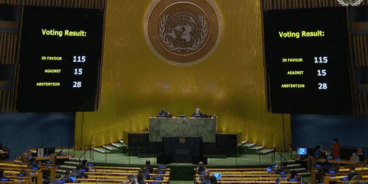
Statement by Dr. Simon Adams on Behalf of the Global Centre for the Responsibility to Protect to the UN General Assembly’s 2012 interactive dialogue on “Responsibility to Protect: Timely and Decisive Response.”
We are grateful to speak at this important discussion on the implementation of the third pillar of the Responsibility to Protect. I would also like to thank the panelists and delegates for their contributions.
Similar interactive dialogues in the UN General Assembly during 2009, 2010 and 2011 demonstrated burgeoning support for the Responsibility to Protect and helped define its parameters. Despite differences of opinion and emphasis, more than 50 member states have come here today to speak about the Responsibility to Protect. This is encouraging, but support for the Responsibility to Protect must be measured not just by speeches and the clarification of ideas, but by praxis.
In terms of institution building, the UN Joint Office of the Special Advisers on the Prevention of Genocide and the Responsibility to Protect has played an important role inside the UN in guiding the development of the Responsibility to Protect. We look forward to working with new Special Adviser Adama Dieng to continue this good work.
In addition, the governments of Australia, Costa Rica, Denmark and Ghana, working with the Global Centre for the Responsibility to Protect, are co-convening the R2P Focal Points initiative. The initiative asks that states appoint a senior official to coordinate national preventive strategies, and collaborate through an international network to enhance efforts to anticipate, prevent and respond to mass atrocity crimes. Seventeen governments from Africa, the Americas, Europe and Australasia have already appointed a Focal Point. We call upon member states to embrace and broaden this initiative.
Despite this institutional progress, the practical necessity to protect civilians from mass atrocity crimes continues to be a major political challenge. Over the last year we have seen the General Assembly, Security Council, Human Rights Council and various regional bodies, notably the League of Arab States and ECOWAS, support a variety of measures to uphold the Responsibility to Protect in South Sudan, the Democratic Republic of the Congo, Côte d’Ivoire and elsewhere.
These examples illustrate that the operationalization of the Responsibility to Protect can not be reduced to the use of military force. While much acrimonious debate has focused upon Security Council Resolution 1973, which authorized military intervention in Libya, hardly anyone discusses Resolution 2014 concerning Yemen. This resolution emphasized the government’s “primary responsibility to protect” its populations and facilitated a meaningful transition away from state-sanctioned violence.
Running right through all three pillars of the Responsibility to Protect is an absolute commitment to prevention: prevention of initial outbreak of a crisis, prevention of its continuation and escalation and prevention of recurrence. The third pillar embraces many less extreme measures – including fact finding missions, diplomatic persuasion, suspension from international organizations, arms embargoes, targeted sanctions and reference to international criminal tribunals. Military force is a measure of last resort, to be deployed when all other options have been tried and failed.
We can not ignore the controversy that continues to plague discussion of the Libya intervention. But we must balance these concerns against the deadly cost of inaction in Syria over the last year. And ultimately, we must acknowledge that if the Security Council had acted as decisively in Rwanda in 1994 as it did in the face of the Gaddafi regime’s assault on Benghazi in 2011, 800,000 Rwandan men, women and children might still be alive today.
What Brazil’s important “Responsibility while Protecting” initiative and many of the statements here today remind us is that prevention remains at the core of the Responsibility to Protect. But we should not contrast prevention and response, which are mutually reinforcing. With UN Secretary-General, His Excellency Ban Ki-moon, designating 2012 to be the “Year of Prevention,” we call upon member states to make prevention a reality by developing better early warning mechanisms and more effective prevention strategies.
It is unquestionable that the UN must exercise extreme caution when implementing coercive measures under the third pillar of the Responsibility to Protect. But we should also recognize that the international community can do more to uphold the solemn promise made at the 2005 UN World Summit to protect all people from genocide, war crimes, ethnic cleansing and crimes against humanity. As Syria has shown us, inaction and indifference still remain our greatest enemies in confronting mass atrocity crimes.
Related Content


Summary of the 2022 UN General Assembly Plenary Meeting on the Responsibility to Protect
